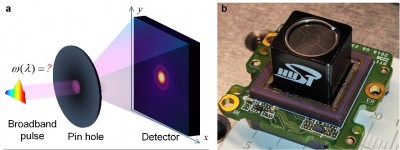Newswise — Spectrometers are crucial scientific instruments in various research fields and have consistently served as indispensable tools for foundational research. However, the unwieldy size of conventional spectrometers poses challenges for cost-effective and compact mobile platforms. In recent years, miniaturizing spectrometers based on spectral spatiotemporal encoding and numerical computation techniques have gained widespread attentions. Nevertheless, complex disperser designs along with advanced material and precision manufacturing technologies primarily underpin existing miniaturized designs. Moreover, intricate calibration issues related to spectral encoding further impede the generalization of simplicity and miniaturization.
In a recent breakthrough, Prof. Shiyuan Liu and his group at Huazhong University of Science and Technology have incorporated the fundamental optical principle of "coherent mode decomposition of broadband diffraction" into their exploration of spectral measurement techniques. Their innovative work has led to the development of an exceptionally streamlined diffraction-based computational spectrometer. The research findings, titled "Ultra-simplified diffraction-based computational spectrometer," have been published in "Light: Science and Applications" and earned recognition as the cover paper.
“We present a novel and straightforward spectrometer design based on one-to-broadband diffraction mapping for spectral encoding. Our innovative approach incorporates an arbitrarily shaped pinhole as a diffraction-based partial-disperser, positioned in front of the detector. This eliminates the need for intricate pre-encoding designs, making the spectrometer ultra-simplified and highly cost-effective, with a core disperser device priced at nearly one dollar (Fig. 1).” The scientists introduced.
“With just a single capture of the broadband diffraction image, we can accurately determine the spectrum of the incident light's spectrum. This achievement is made possible through coherent mode decomposition of the captured broadband image. Notably, we have introduced an innovative mapping method based on spectrum-based point spread function derived from a single capture of a monochromatic diffraction image. This mapping enables the generation of a complete spectral response function in spectral spatiotemporal encoding, eliminating the need for pre-encoding design, intricate high-precision fabrication or calibration of the full spectral response function (Fig. 2).” They added.
“Our developed spectrometer has demonstrated a reconstructed spectral peak location accuracy better than 1 nm over a bandwidth of 200 nm and a spectral peak resolution of 3 nm, within a compact footprint under half an inch (Fig. 3). This represents the first demonstration of a spectrometer design that integrates an ultra-simplified and arbitrarily shaped diffraction structure. Our design enables single-shot spectrum measurements across a wide wavelength range, from ultraviolet to infrared, with miniaturized lab-on-chip integration. This advancement is crucial for portable applications, offering high robustness, low cost, and long-term stability.” The scientists forecast.
###
References
DOI
Original Source URL
https://doi.org/10.1038/s41377-023-01355-4
Funding information
This work was supported by the National Natural Science Foundation of China (52130504), Key Research and Development Program of Hubei Province (2021BAA013), Innovation Project of Optics Valley Laboratory (OVL2023PY003), Fundamental Research Funds for the Central Universities (2021XXJS113), and Guangdong Basic and Applied Basic Research Foundation (2023A1515030149).
About Light: Science & Applications
The Light: Science & Applications will primarily publish new research results in cutting-edge and emerging topics in optics and photonics, as well as covering traditional topics in optical engineering. The journal will publish original articles and reviews that are of high quality, high interest and far-reaching consequence.
MEDIA CONTACT
Register for reporter access to contact detailsArticle Multimedia

Credit: Light: Science & Applications
Caption: Fig.1 The proposed ultra-simplified diffraction-based spectrometer

Credit: Light: Science & Applications
Caption: Fig. 2 Principle of the one-to-broadband diffraction-based spectrometer

Credit: Light: Science & Applications
Caption: Fig. 3 Spectra measurements. a, multi-pulse spectrum measurement featuring 4 narrowband peaks. b, spectral resolution measurement of a bimodal spectrum with peaks of 3 nm separation. c, measurement of a broadband spectrum with complex features. d, the mean spectrum of five trails of spectral measurements and the corresponding error bar (standard deviation).


